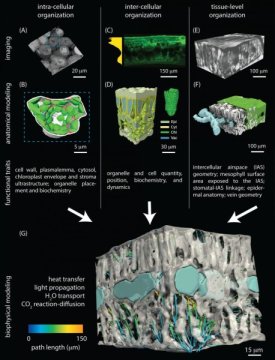[ad_1]
The field of plant science is in the process of being profoundly transformed by new imaging and modelling technologies. These tools are allowing scientists to peer inside the leaf with a clarity and resolution inconceivable a generation ago.
In a recent publication, a team of Australian and US scientists demonstrated how three-dimensional (3D) imaging can now reproduce the inner reality of the leaf, including the dynamic carbon and water exchange processes.
Professor John Evans, from the Research School of Biology at the Australian National University (ANU), and one of the authors of the research, said that although leaves and plant cells are three dimensional, plant biologists use highly simplified 1D or 2D models, evading the difficult, confounding and beautiful 3D reality.
“The leaf is an amazingly complex landscape, where water and gases flow in many directions depending on variables such as temperature, light quality and wind. 3D images give you an understanding of what is really happening,” said Professor Evans, who is a Chief investigator at the Australian Research Council Centre of Excellence for Translational Photosynthesis (CoETP).
These technologies make it possible to answer very interesting questions, some of which have eluded scientists for many years,” he said.
The images are created from biological specimens, by integrating 2D leaf measurements to create 3D volumes and surfaces. The 3D representation enables an anatomically correct basis for modelling and biophysical simulations to provide a dynamic view of the processes inside plant cells and tissues.
“In this article, we show the huge potential that embracing 3D complexity can have in improving our understanding of leaves at multiple levels of biological organisation, including harnessing the knowledge to improve the photosynthetic performance of crops,” said Professor Margaret Barbour from the University of Sydney and a CoETP Associate investigator.
“It is a bit like being able to walk inside the leaf, instead of looking at it squashed in two dimensions,” Professor Barbour said.
The scientists predict that using a collaborative approach, they will be able to answer, within the next decade, outstanding questions about how the 3D special arrangement of organelles, cells and tissues affects photosynthesis and transpiration.
Story Source:
Materials provided by University of Sydney. Note: Content may be edited for style and length.
[ad_2]















